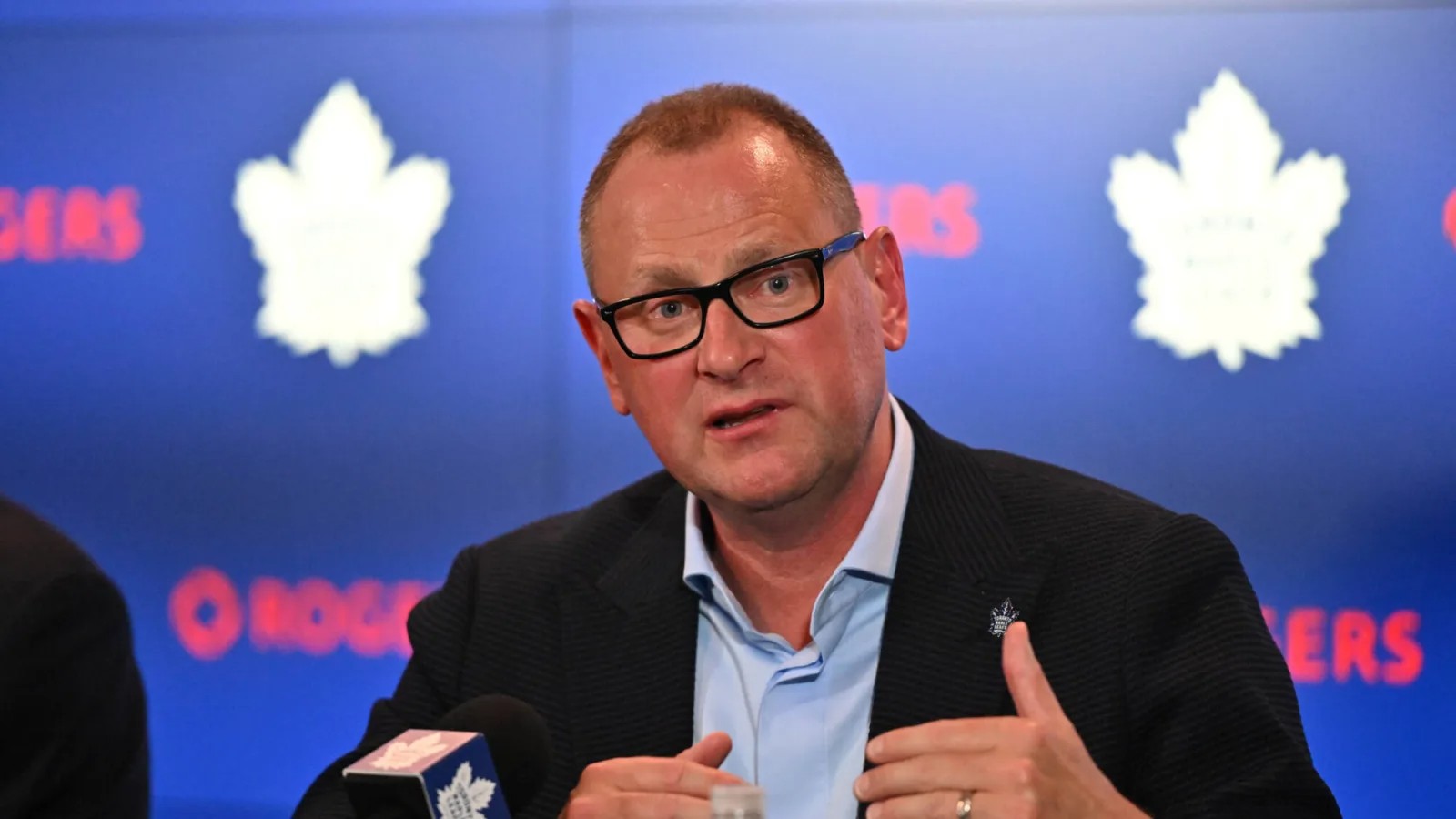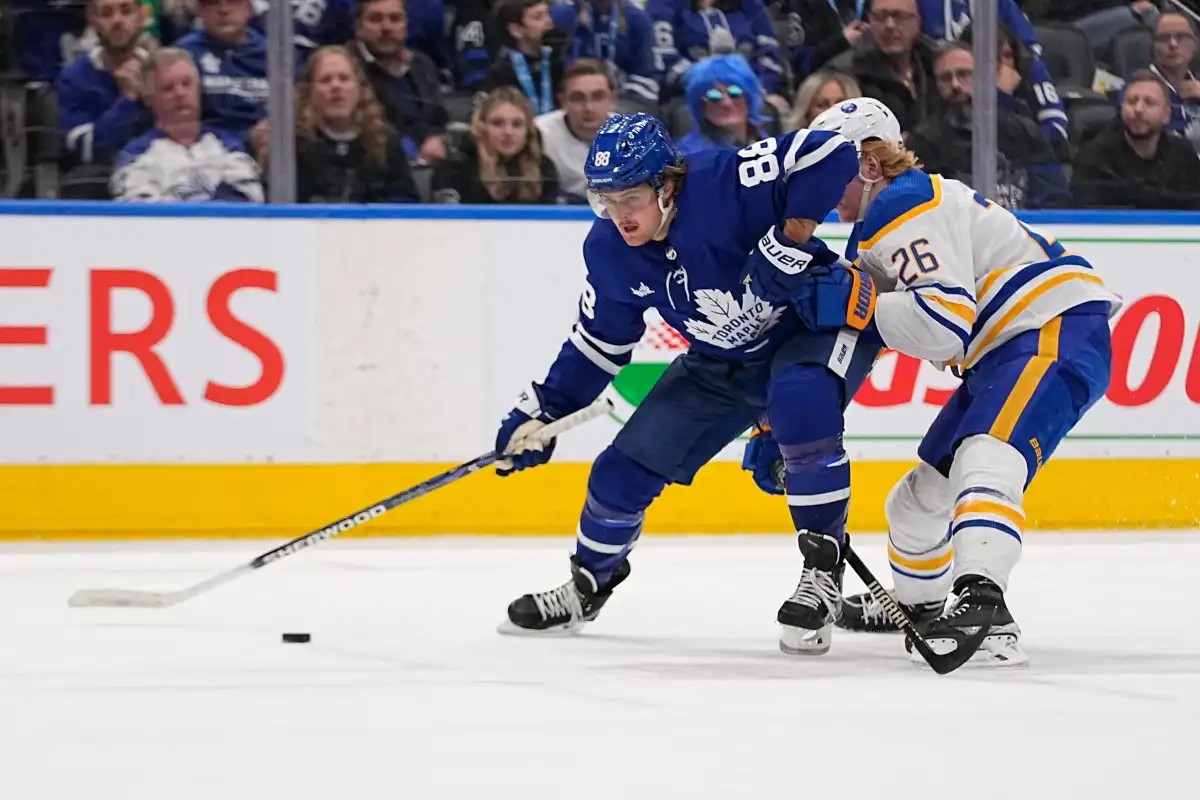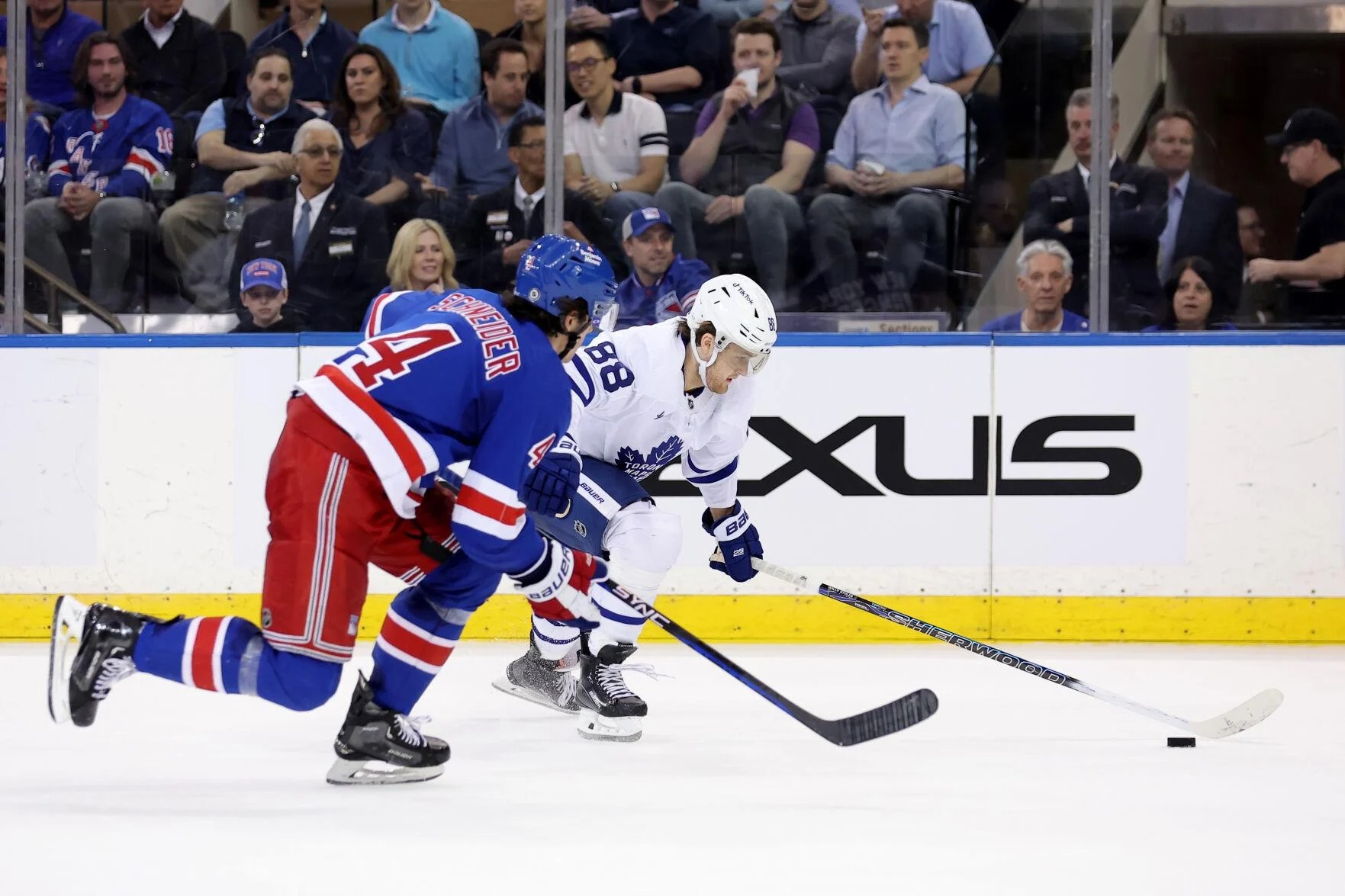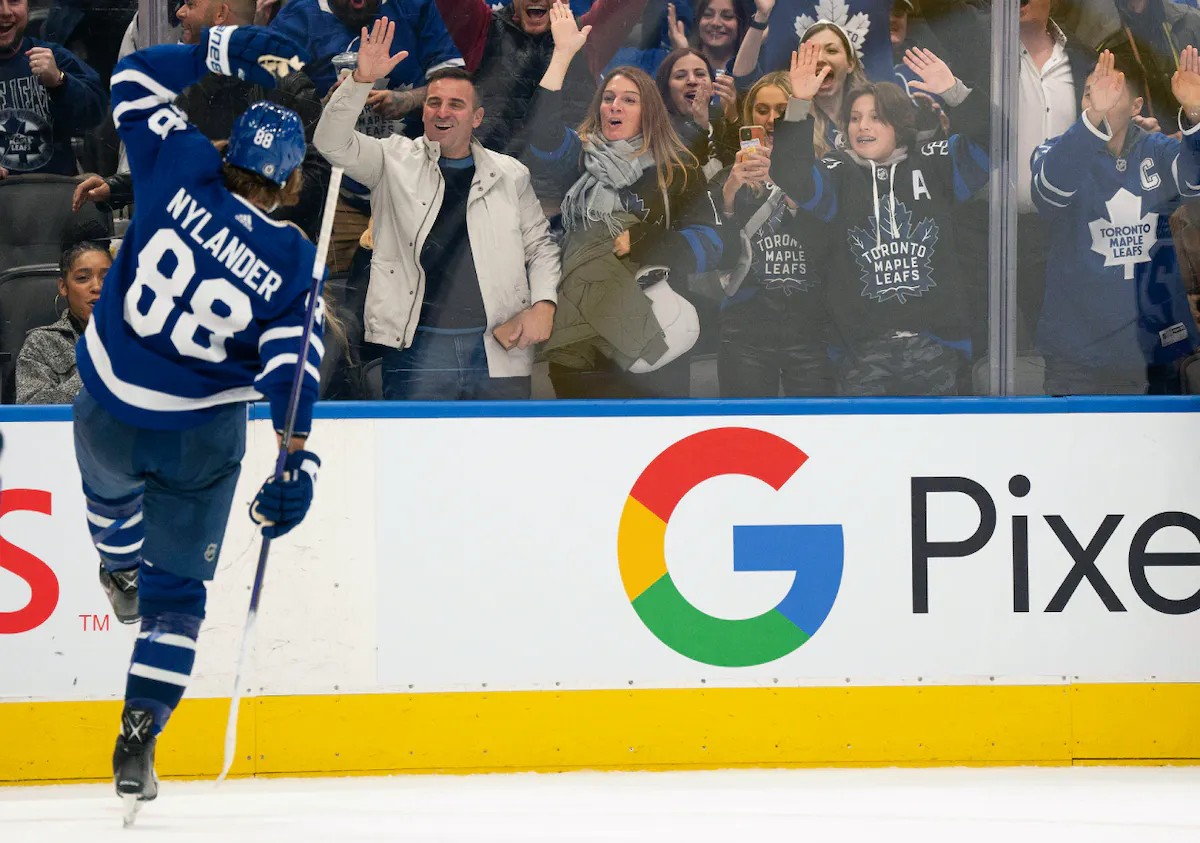As the numbers continued to pile up night after night during William Nylander’s season-opening 17-game point streak, it felt like his asking price in contract negotiations would naturally follow suit.
Suddenly, his reported $10 million asking price – one many people balked at in the summer – did not seem so unreasonable. This week, in an interview with Brendan Shanahan, TSN’s Gino Reda bluntly stated, “With the way Nylander is playing, the price seems to be going up and up and up.”
Since Nylander’s long streak was snapped against Chicago, he has produced a much more modest two points in five games. As his production starts to normalize and the Leafs reach the quarter pole of the season, it’s a reasonable time to discuss where the situation currently sits with Nylander’s next contract.
The critical timeline for Brad Treliving and the Maple Leafs

The key date to keep in mind is March 8, 2024 – the day of the NHL trade deadline.
If Nylander remains unsigned past that date, he basically holds all the leverage at that point. The Leafs wouldn’t be able to trade him for any real value short of executing a small sign and trade – in other words, they would facilitate the signing of a high-end player with a new team while fetching pennies on the dollar via trade.
When a player ends up so close to free agency, it almost behooves them to test their value on the open market. Potentially compounding matters in this regard is the history and reputation of Nylander’s agent, Lewis Gross.
Almost all of his clients end up testing free agency, headlined by Johnny Gaudreau in the summer of 2022. Other clients of Gross’ include:
- Brandon Saad
- Torey Krug
- Brian Dumoulin
- Noel Acciari
- Connor Sheary
All of these players hit the open market and left their prior teams (and I’d argue almost every one of those players is worse off for it from a hockey standpoint). The only notable client of Gross’ who actually signed instead of hitting the open market is Alex Iafallo, who signed his extension on trade deadline day of 2021 as the Kings were simply going to trade him if they couldn’t reach an agreement.
Seemingly every negotiation with Lewis Gross comes down to the wire, and Brad Treliving has firsthand experience with this exact situation having previously lost Gaudreau for nothing.
In his quarter-season review, Treliving was asked about Nylander, and while the Leafs GM is not going to tip his hand too much (nor should he), he provided a fairly levelheaded response to the situation:
“Willy has had a tremendous start to the year. I don’t think this is just a hot start. I think he is a really good player… He has had his great start — great for him and great for us — but it doesn’t change in any way. We just continue to work away at it.”
It is a great start for Nylander – that’s obvious – but the question in regards to the contract centers around how much the team is buying what he is selling at the moment.
Contextualizing William Nylander’s hot start and the parameters of a fair deal

Across the board, Nylander is enjoying an outlier (contract) year.
| William Nylander | Career average | Best full season to date | This season so far |
|---|---|---|---|
| Assists per game | 0.5 | 0.57 | 0.77 |
| Goals per game | 0.35 | 0.49 | 0.55 |
| Points per game | 0.85 | 1.06 | 1.32 |
| Shots per game | 2.85 | 3.57 | 4.5 |
| Time on ice | 17:19 | 18:33 | 20:41 |
Mike Kelly recently posted some additional statistical context around Nylander’s hot start – data that aligns with what our eyes are seeing on the ice:
Nylander drives the slot, drops the shoulder and wins it in overtime.
Huge part of his success this season…
➡️https://t.co/6AOkpjRsCD https://t.co/B3itaTSkgN pic.twitter.com/hyIExDd8lU— Mike Kelly (@MikeKellyNHL) November 19, 2023
It is very clear that Nylander is producing at a level he’s never come close to reaching before, and he is doing things on the ice (namely, driving the net) at a higher-than-ever-before level. His shooting percentage has actually dipped this season – it is slightly below his career average (12.1 vs. 12.3) – but when a player is shooting more, driving the net more, and playing more minutes, the numbers tend to work out in their favour overall.
One could argue that this is simply the new Nylander, but he’s turning 28 years old, and we have a huge sample of data at this point to suggest that these numbers are out of the ordinary by Nylander’s standards.
This is not intended as a knock on Nylander or his accomplishments this season to date, but it’s December, the season isn’t close to halfway over, and the Leafs have to be realistic when it comes to the parameters of his next contract.
Nylander is still a productive, top-line player, but heading into this season, his career point-per-game rate was .82, which was identical to Filip Forsberg’s output when he signed his eight-year, $68 million contract with an average annual value of $8.5 million.
While he might not have produced the kind of season Nylander is potentially about to put together right before UFA eligibility, Forsberg was a year younger at the time he signed his current deal.
When Gaudreau signed his current contract for $9.75 million per season with Columbus, he was coming off of a 115-point season and had amassed 609 points in 602 career games. While he has struggled so far in Columbus, at the time his current contract was signed, Gaudreau’s career accomplishments were a clear notch above Nylander’s.
Clear comparables are available which should provide an anchor in negotiations rather than simply working off of Auston Matthews’ contract (he’s scored the most goals in the entire league since he entered it and has won multiple awards) or even Mitch Marner’s (who has outproduced Nylander in every single season of his career except his rookie season – when they were tied in points – and plays in more situations). A hot 22 games or so to start a season really shouldn’t alter this equation too much.
Complicating matters further is the rising salary cap and projecting any sort of inflation. The cap estimate for next year, provided at the recent Board of Governors meeting, is approximately $87.675 million.
For what it’s worth, if we worked off of Forsberg’s cap hit percentage when he signed of 10.3 percent and applied it to the new projected salary cap, the annual average would be $9.1 million. Even if Nylander continued apace with his contract-year production – and it was recognized with an additional pay bump, to some degree – the number really shouldn’t surpass $9.5 million, especially when we consider that the Leafs can tag an extra year onto his contract that no other team can offer.
Interest goes both ways, but the clock is ticking

There is a clear path to a contract extension that ensures Nylander is paid fairly and the Leafs lock in a quality player through the rest of his prime years. For his part, unlike the Johnny Gaudreau or Matthew Tkachuk situations in Calgary, Nylander has made no bones about wanting to stay in Toronto:
“It would take a lot for me to want to leave Toronto. Like, that’s a place I want to be at. And that’s where my mind’s at for the coming year and for the future. I’m not thinking about being anywhere else.”
However, if there’s no contract in place by March 8, 2024, there is a real problem on the Leafs’ hands. Losing a top-line player for absolutely nothing is the type of development that sets an organization back years.
Look no further than Treliving’s old team in Calgary, who lost Gaudreau for nothing, barely missed the playoffs afterward, and will be in tough to make it again this season. Any return of real value rather than Gaudreau walking for free likely would’ve been enough to push them into the playoffs last season – or, if nothing else, it would’ve set their franchise in a proper direction compared to their current murky middle-ground situation.
The purpose of this piece isn’t to go through the trade options should it come to it. We’re months away from it becoming a real conversation, but the trade deadline timeline is the aspect that looms large at the moment – much more than a hot start to this season.
For the Leafs’ side, Nylander is clearly a player they should want to retain. We’ve said this before in this space, but losing Nylander a year before a new contract negotiation with Mitch Marner is a borderline disaster. The last negotiation with Marner was untenable, with threats of offer sheets and unprecedented salary demands for a restricted free-agent winger at the time. Imagine entering a new negotiation with Marner only this time he is a pending UFA and Nylander isn’t on the roster?
Nylander has also clearly proven to be a great fit for the Toronto market. Some players claim they don’t care about the fan and media noise in the city, and then some players actually don’t care. Nylander is one of the latter. Whether it’s that he revels in the scrutiny or remains aloof to it, his personality suits the unique pressures of the market. Notably, he has produced some strong playoff showings, too.
Brad Treliving has been in this situation before – right down to the same agent. The first time went poorly; Calgary fizzled out of the playoffs in the second round before losing a star for nothing, and the franchise has struggled since. The Leafs GM needs to show he has learned his lesson, one way or another.
Since he was hired in Toronto, Treliving’s consistently stated goal is to retain Matthews and Nylander. The Matthews contract is done, but with Nylander, the ticking clock is growing louder and louder with each passing day.






























![New Leaf Anthony Stolarz on the opportunity in Toronto: “In Florida, I knew my role as a backup… Now, [Joseph Woll] and I are competing for starts… As a goalie, that’s all you can ask for” Anthony Stolarz, Stanley Cup win, now Maple Leaf](https://mapleleafshotstove.com/wp-content/uploads/2024/07/anthony-stolarz-sc-100x70.jpg)
